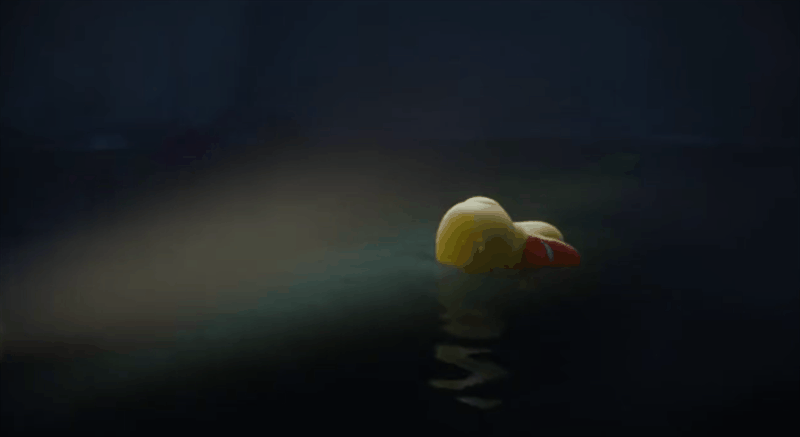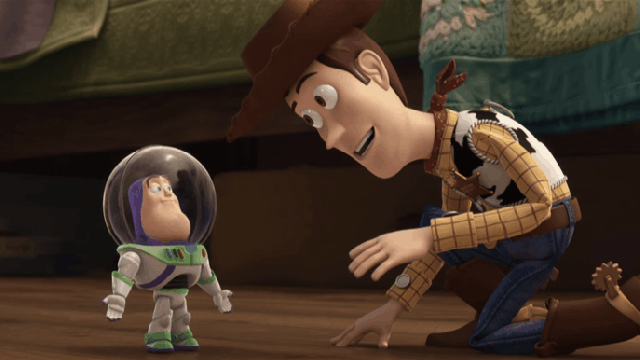The Toy Story movies have been very good. But it’s Pixar’s five short films in the series — many of which have never been seen by the main trilogy’s adult fans — where some of the real magic lies.
If you’re a grown-up who hasn’t seen Small Fry or Partysaurus, that’s OK. Unlike the feature films, which are marketed at anyone with a pulse and a wallet, Toy Story’s shorts (especially the older ones) have generally been handled by Disney in much the same way as it used to treat the direct-to-VHS sequels to movies like Lion King: aimed at kids and slid out the door, content to act as fanservice dessert to the theatrical main meals.
This is a damn shame! Because it’s when Toy Story is forced to strip back and focus solely on its simple hook — hey, what do toys do when you’re not around? — that it really shines.
Consider: every single Toy Story tale is, at its heart, an exploration of an aspect of our use and ownership of toys. The arcs that every character goes through in the course of dealing with this is excellent window dressing, and a great way to pad out a short premise into a two-hour movie, but it’s not the ground floor of the story being told.
Look at the first Toy Story, which is about two things: the deep insecurity a toy would feel at its impending replacement (Woody vs Buzz, Rex panicking over new dinosaur toys), and that kid everyone knew — portrayed unfairly here as a villain — who treated his action figures like shit.
Toy Story 2, meanwhile, is based around two things: the deep insecurity a toy would feel at its impending abandonment (Woody and his broken arm, Jessie’s origin tale), and the heartless economics of hoarding toys not as playthings, but as investments.
And Toy Story 3, for all its closure and jerking of tears, is about…well, whaddya know, the deep insecurity a toy would feel at its impending abandonment and demise (almost every toy in the movie, from Woody to Barbie to Lotso). And the perilous journey a toy is forced to take from its previous owner to wherever it ends up next. Oh, and also the contrast between the way toys are played with by kids of different ages. Yeah, there’s a lot more stuff going on with Toy Story 3, but then it’s easily the best film of the three, so whatever.

Across the three movies, we’re given representative glimpses at a typical human’s relationship with toys across the ages. An infant Molly smashes up Andy’s carefully-arranged playset. Toddlers at Sunnyside are stupid, destructive monsters. Older kids at Sunnyside coddle their toys and begin their first exploration of proper “play”. School-age Andy’s imagination is exploding as he puts Woody and Buzz through bizarre, amazing adventures. An adolescent girl abandons Jessie under her bed for years as she eases out of playing with toys and into magazines and music. And finally, a nearly-adult Andy, despite his lingering attachment to his childhood friends, accepts that as he leaves for college it’s time to say goodbye.
These moments resonate and tug at our heartstrings not necessarily because of the characters portraying them — as wonderful as nearly the entire cast is — but because they’re vessels through which Pixar force us to revisit our own relationship with toys, through universal situations that nearly everyone under the age of 50 (or maybe even older!) would be able to relate to.
That’s why, for example, the end of Toy Story 3 is such a punch in the gut. Yes, it’s nice that Woody and Buzz are getting a new owner, but it’s the way Andy’s farewell echoes our own coming of age (and parting with our own childhood companions) that brings on the tears.
Like the three main films, each of the five Toy Story shorts is based around a simple hook, a facet of toy design, treatment and/or ownership. Unlike the movies, however, these things only run for 7-23 minutes. So they do not have time to mess around.
There’s little room for character development, or complex plotlines. They have to pick their mark, hit it, hit it well and get out the door.
And boy do they deliver. Their lesser profile might have you thinking they’re not to the same high standards as the theatrical releases, but really, it’s the opposite.
The hooks are stronger. The settings leaner and firmer. And most importantly of all — and perhaps because of the last two points — the jokes are funnier.
In all, there have been five Toy Story shorts released since Toy Story 3. The first three, released under the Toy Story Toons label, run for around 6-7 minutes each. The last two, made specially for TV, are 23 minutes long.
PARTYSAURUS: I have no idea how this got made. Ostensibly about the longing bath toys feel between playtime sessions, it’s framed as a rave, complete with multiple drug and club references, from the trademark “camera on my chest cos I’m high as hell” perspective to hot girls asking to cut in line.
The star of Partysaurus is Rex, freed from his role of comic sidekick and allowed some time in the spotlight as a comic lead. Which he nails, the frantic uncertainty as he flits between dork and hero leading to the greatest Disney party of all time.
HAWAIIAN VACATION: Ken, the real hero of Toy Story 3, is rewarded here with his own short, as a failed attempt to smuggle his way to Hawaii ends with the gang pitching in to simulate a tropical vacation. Again, there’s some good adult stuff on show — Ken’s longing for a “first kiss” with Barbie is alluded to being a lot more than first base — but really, this is just an excuse for everyone to enjoy an encore of Michael Keaton’s fabulous turn as the manic fashionista.
SMALL FRY: Ah, Small Fry. Where do I even begin. The story here, of Buzz being kidnapped and replaced by a tiny jealous replica, is OK. But what’s amazing about Small Fry is the way Pixar’s artists and writers have excelled in recreating the absurdity of both fast food retailers and the meal toys they peddle. The montage of fictional figures in the middle of the short is incredible. The fake chicken menu in the closing credits is from another world.
TOY STORY OF TERROR: Bonnie’s toys are forced to spend the night in a roadside motel, where they’re systematically stolen by a creepy eBay reseller. Starting off as a homage to old horror flicks, it actually morphs into a monster action movie halfway through. Carl Weathers makes a double-referential cameo here, reprising his roles from both Predator and Happy Gilmore at the same time, but it’s Pixar’s long-overdue Transformers homage that nearly steals the show.
TOY STORY THAT TIME FORGOT: The most recent short — written and directed by Sam & Max’s Steve Purcell — sees a selection of Bonnie’s toys taken on a playdate with a token “rich friend”. You know the arsehole, lives in a giant house, gets every toy in the set for Christmas, opens them and doesn’t even play with them before heading off and playing with some other expensive rich kid toy.
In this case, the ignored toys are a complete set of badass dinosaur warriors, riffing on the militaristic boy’s action figures of the 80s (complete with theme song). Like Buzz in the first Toy Story, they’re unaware they’re actually toys, and are very into killing. Unlike Buzz, the gentle touch of Kristen Schaal is here to sooth the savage beast.
I wish Toy Story 4 was not being made. The end of Toy Story 3 was, in terms of framing the gang’s adventure as a cinematic trilogy, about as much as we could ask for. As has been the treatment of the cast since. We’ve already followed one kid — Andy — on his journey from boy to man, as well as his toys, we don’t need to track another kid’s development and watch everyone grow old with their new owner, Bonnie.
Instead, through the shorts we’ve been given multiple snapshots of everyone’s post-Andy adventures, each given the freedom to explore a side of toys that a movie hasn’t had a chance to, with little of the burden that committing to an actual feature film includes.
Are any of these newer characters any less rounded or loveable than those we’ve seen across one (or three) feature-length films? I don’t think so. Reptillus Maximus and Combat Carl are as interesting and funny as anyone Pixar dreamt up back in the ’90s, if not more so (go back and watch Toy Story 1 and witness how many of the toys are one-dimensional arseholes).
Sure, you could say is an indictment of the writing of the movies, but that’s unfair; instead I think it’s testament to the skill involved in these shorts (and how well they’re able to take advantage of our pre-existing knowledge of toy tropes like GI Joe figures).
One of my favourite quotes in both video games (Civilization IV) and the real world comes from the French writer and aviator Antoine de Saint Exupéry, who famously remarked:
A designer knows he has achieved perfection not when there is nothing left to add, but when there is nothing left to take away.
I like to think Pixar had that strung up over the front door while making the Toy Story shorts, because that’s exactly the kind of perfection they have achieved.

Comments
2 responses to “The Toy Story Shorts Are Awesome, And You Should Watch Them”
Toy Story that time forgot. I saw this and was convinced it was a cheap spin off as Buzz and Woody seemed to be voiced by completely different actors to the originals. It really grated on me.
I will have to track them down again and catch.
Thanks for this! My kids are obsessed with Toy Story and they’ve ruined the movies for me as we’ve seen them a 100 times each. Will grab these tonight so they we can watch something new! 🙂
And I agree about Toy Story 4, they should just leave the franchise alone now.